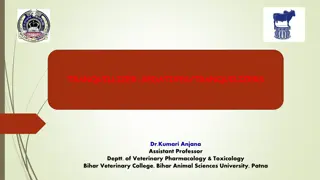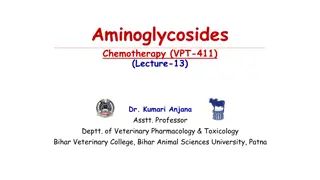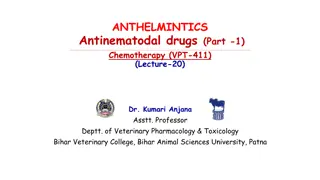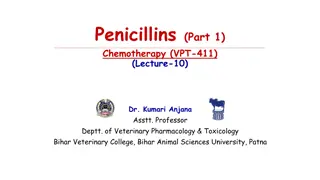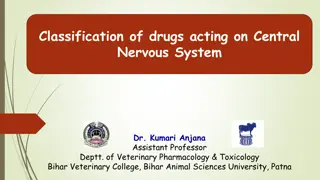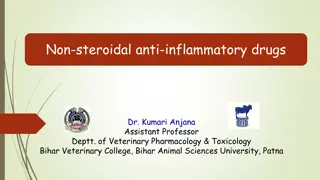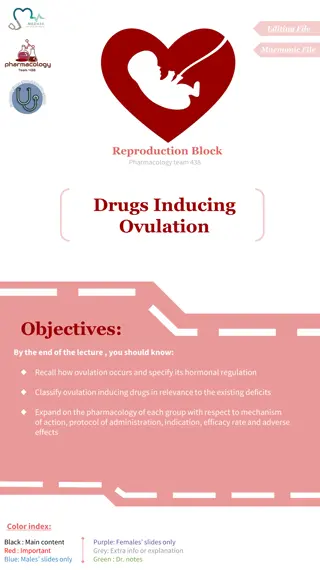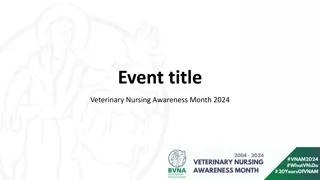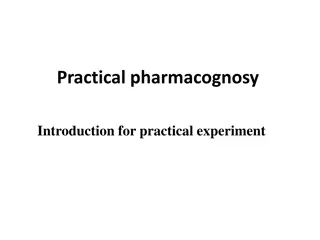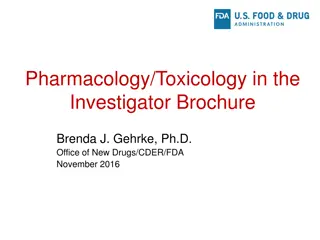Overview of Anticestodal Drugs in Veterinary Pharmacology
Anticestodal drugs play a crucial role in combating tapeworm infections in veterinary medicine. These drugs are classified into taeniafuges and taenicides, with examples of natural and synthetic compounds highlighted. Natural compounds like pumpkin seeds and male fern are traditionally used for their anthelmintic properties. Additionally, synthetic organic compounds and inorganic compounds are also utilized in the treatment of cestodes. Understanding the classification and mechanisms of action of these drugs is essential in managing parasitic infections in animals.
Download Presentation

Please find below an Image/Link to download the presentation.
The content on the website is provided AS IS for your information and personal use only. It may not be sold, licensed, or shared on other websites without obtaining consent from the author. Download presentation by click this link. If you encounter any issues during the download, it is possible that the publisher has removed the file from their server.
E N D
Presentation Transcript
ANTHELMINTICS Anticestodal Drugs Chemotherapy (VPT-411) (Lecture-22) Dr. Kumari Anjana Asstt. Professor Deptt. of Veterinary Pharmacology & Toxicology Bihar Veterinary College, Bihar Animal Sciences University, Patna
Content of the chapter Anticestodal Drugs Natural compounds Inorganic compounds and Synthetic organic compounds.
Anticestodal Drugs These are the drug effective against cestodes or tapeworms and are of two types: Taeniafuges: These drugs simply cause expulsion of tapeworms. They generally paralyze the tapeworm and are combined with purgative to facilitate expulsion. e.g. older natural organic anticestodal drugs like arecoline. Taenicides: They cause actual death of the tapeworms in situ. e.g. synthetic organic compounds like bunamidine.
Classification Pumpkin seeds, Male fern Kamala, Nicotine Arecholine Natural compounds Bunamidine hydrochloride Niclosamide Dichlorophen, Hexachlorophene, Resorantel, Bithionol, Bithionol sulphoxide, Uredophos, Nitroscanate, Praziquantel, Benzimidazoles- Mebendazole, Fenbendazole Synthetic organic compounds Anticestodal Drugs Inorganic compounds Tin compounds Lead arsenate
Natural compounds Pumpkin seeds: The minced pumpkin seed has anticestodal activity and still used in some countries. The cucurbitine. active principle is It has low efficacy but high safety even in debilitated and young patients. Fig: pumpkin seed Source : Google image
Male fern(Dryopteris Felix Mas): The powdered rhizome of this fern was best known and had been most commonly used physicians against human cestodes. by the Greek The active principle was found to be filicic acid that caused paralysis of the tapeworm. Fig: Male fern Source : Google image
Kamala: Source: Glands and hairs covering of fruits of a plant Mellotus philippinensis. Found in Philippines, India, and China. Previously it was the drug of choice for cat tapeworms like Dipylidium caninum and Taenia taeniformis. Kamala:Mellotus philippinensis Philippine Medicinal herb Source : Google image Kamala cestodes and host intestinal muscle and never used in veterinary medicine. causes paralysis of both
Nicotine: Source : Nicotiana tabacum. It was commonly used with copper sulphate for removal of ruminant tapeworms and roundworms. The drug causes persistent neuromuscular junction followed by paralysis of the worm. The efficacy and safety of the drug are low. depolarization of the
Arecholine: It is an alkaloid obtained from Seeds of betel nut palm, Areca catechu. Used in dogs. Arecholine itself is unstable so its stable salts are used. Fig: Seeds of betel nut palm, Areca catechu Source : Google image
Arecoline hydrobromide: Against all tapeworms of dogs (Taenia, Dipylidium) including Echinococcus. It has two fold action. Act as cholinergic agonist, paralysis detachment of the worm and also increase the peristaltic movement of the intestine so that the detached worm is expelled by purgation. The drug causes only temporary paralysis of the worm. So if purgation does not occur within 2 hours of medication, a saline purgative is given to dogs to induce evacuation. Contraindicated in cats- increase tracheobronchial secretions. Excessively increase the tracheo-boronchial secretion and thereby causes suffocation.
Arecoline acetersol: Active moiety- arecoline. The drug is used in dogs and cats as anticestodal against Taenia and Dipylidium and as a laxative. Arecoline carboxyphenylstibonate: It is used in dogs as an anticestodal drug against Taenia and Dipylidium.
Synthetic organic compounds Bunamidine hydrochloride: Good activity against all tapeworms of dog and cat including Echinococcus granulosus. MOA: Bunamidine salts disrupt the tegument of the parasite resulting into reduced rate of glucose uptake and ultimate death of the parasite. The dead worms are digested in the host gut.
Toxicity: Vomiting and diarrhea. The drug may cause sensitization of heart muscle to catecholamine and sudden death of animals. Bunamidine hydroxynaphthoate: The drug is safely used against Moniazia sp. in sheep and goats even in pregnancy.
Niclosamide: Tapeworm infections (mainly for Taenia) of dog, cat and man but it has poor efficacy against Echinococcus and variable for Dipylidium. It is also used against Moniezia and Thysaosoma infection in ruminants and Tapeworm infections in lab, animals, monkeys and reptiles. Intestinal flukes such as Paramphistomum in ruminants. Metabolized to inert amine rapidly excreted in urine. Safe for all stages of pregnancy and in debilitated animals. Niclosamide is extensively used as a taenicide both in human and vety. Medicine.
Dichlorophen: It is mainly used as a narrow spectrum taenicide in veterinary medicine. It is effective against Taenia and Dipylidium in dogs and cats. But it is ineffective against Echinococcus, thus it is not the drug of choice for this tapeworm. The drug has bactericidal and fungicidal properties. Orally available as tablets or suspension - after overnight fasting. Pugative is not required. Dog, Cat and Sheep: 200 mg/kg
Hexachlorophene: It is mainly used as an antitrematodal drug for the treatment of liver fluke infection in sheep and cattle. The main anticestodal use of this drug is for the control of chicken tapeworms, especially of Raillietinacesticillus. Fig: Tapeworm in chicken gut Source : Google image The drug is toxic to dogs.
Resorantel: It is an anticestodal for ruminants. It is highly effective against Moniezia in both sheep and cattle and against Thysaniezia gardi in sheep. It has 90% efficacy in sheep and cattle against adult and immature rumen flukes (Paramphistomum spp.).
Bithionol: It has anthelmintic as well as bacteriostatic and antifungal activities. Used tor the treatment of Tapeworm infections (Taenia) dogs, cats and poultry. The drug is also used for Tapeworm (Moniezia and Thysanosoma) Rumen fluke (adult and immature Paramphistomum) infections of sheep, cattle and goats. Lung flukes (Paragonimus spp) in dogs and cats.
Bithionol sulphoxide: The special advantage of this drug is that it has equal anticestodal efficacy to bithionol in dogs, sheep at lower therapeutic dose level of 60 mg/kg. Excellent efficacy against liver flukes of both sheep and cattle.
Uredophos: A OP compound, introduced as broad spectrum anthelmintic for use against both nematode (Ascaris and hookworms) and cestodes of dogs and cats at the dose rate of 50 mg/kg. The most important feature of the drug is that it is 100% efficacy against Dipylidium caninum that is resistant to most other anticestodal drugs excepts praziquntel.
Nitroscanate: It is active against tapeworms and roundworm of dogs but not suitable for cat. It is very safe and can be given to pups and pregnant and lactating bitches.
Praziquantel: Chemically it is an isoquinoline and colorless, crystalline and bitter compound. It is a new broad spectrum anthelmintic effective against all species of Schistosomes pathogenic to humans and has unique, extremely high activity wide range of adult and larval cestodes of both animals and man (including Cysticercosis). It is also effective against ruminant and snake tapeworms and certain flukes. But it has no activity against nematodes.
Benzimidazoles: The cestocidal benzimidazoles are: Mebendazole: Taeniasis in Dog and Cat: @ 22 mg/kg/day for 5 days; For adult Echinococcus @ 160 mg/kg. For Moniezia in ruminants: @ 20 mg/kg. Fenbendazole: Taeniasis in Dog and Cat: @ 50mg/kg/day for 3 days. Both drugs are ineffective against D. caninum. Oxfendazole, Cambendazole and Albendazole: For Moniezia in ruminants: @ 7.5-15 mg/kg.
Anticestodal drugs for Horses: Drugs for Equine Tapeworms (Anoplocephala spp). Mebendazole: @ 20 mg/kg; Niclosamide: @ 88 mg/kg ; Dichlorophen: 20 mg/kg Bithinol: 7 mg/kg; Pyrantel palmate: @ 13.2 mg/kg. Fig: Horse tapeworm Source : Google image
Inorganic compounds TIN COMPOUNDS: Metallic tin with its oxide (stannous oxide) or chloride of di-n- butyl tin dilaurate: Highly effective against tapeworm, such as T. solium, T. saginata and Dipylidium in dogs; Davinea in poultry. Extensively used as anticestodal in man and domestic animals.
LEAD ARSENATE: Highly effective against Moniezia and used worldwide for the treatment of Moniezia infection in lambs, calves and kids. Low margin of safety and it should never be used in poultry.
Summary Anticestodal compounds and Synthetic organic compounds. Drugs: Natural compounds, Inorganic Bunamidine hydrochloride: Good activity against all tapeworms of dog and cat including Echinococcus granulosus. Resorantel: It is an anticestodal for ruminants. Nitroscanate: It is very safe and can be given to pups and pregnant and lactating bitches.
References B.K.Roy., Veterinary Pharmacology and Toxicology 2011, Kalyani Publication, pp -459-465. H.S. Sandhu and S. Rampal., Essential of Veterinary Pharmacology and Therapeutics , pp- 1268-75. Prasad V. Vani. and Koley K.M., Synopsis of Veterinary Pharmacology and Toxicology 2006, Vahini Publications, pp-249-253.




